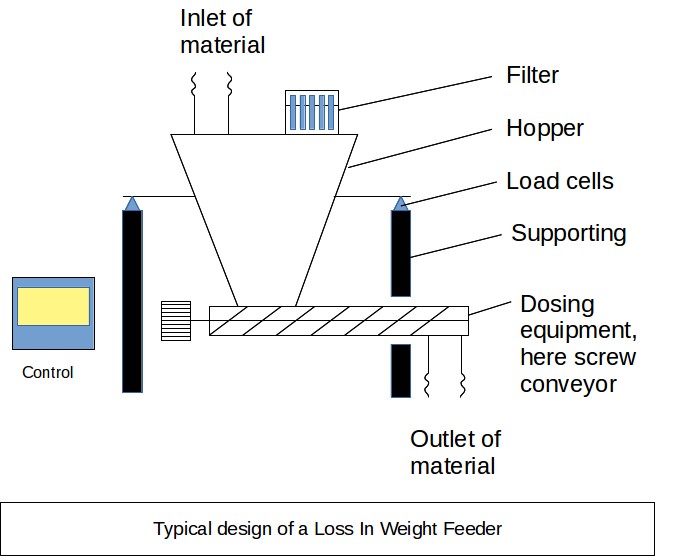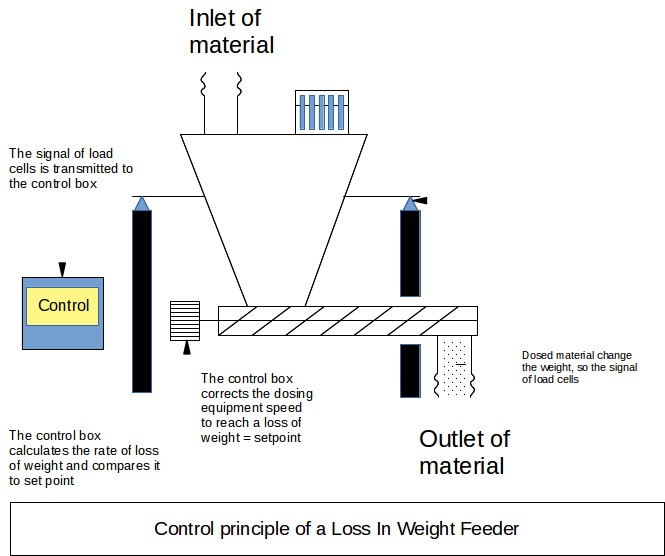
Loss in Weight Feeders
Design and use of Loss In Weight Feeders for continuous dry mix
Follow us on Twitter ![]()
Question, remark ? Contact us at admin@powderprocess.net
| Section summary |
|---|
| 1. Definition of
Loss In Weight Feeder |
| 2. Control of
dosing |
| 3. How to design a
Loss In Weight Feeder |
| 4. Suppliers of Loss-in-weight feeders |
1. Definition of a Loss In Weight Feeder
What is a Loss in weight feeder ?
Loss In Weight Feeder - LIWF - are feeders which are able to measure their change of weight over time and control it. The feeder is made of a hopper and of a dosing instrument that can be a single screw, a double screw, a vibrating tube or a belt for the most common models. Such a system is used to weight a precise quantity of solids, either on a batch basis for the simpler models, or through a continuous feed for most complex ones.

Figure 1 : Typical design of a Loss In Weight Feeder
Batch dosing is straightforward, thus the rest of this page is more focused on continuous dosing, especially to a continuous dry mix.
2. Control of dosing
How a Loss In Weight feeder works ?
The control of a Loss in Weight Feeder is done through a feedback loop from the signal of the load cells to the speed of the motor. The signal of the load cells is sampled over very short interval of times in order to calculate the rate of discharge of the product. If the throughput is lower than expected the dosing equipment speed, for instance a screw conveyor, is increased. If it is too high, the dosing equipment is tuned to a lower capacity.

- Figure 2 : Control philosophy a Loss In Weight Feeder
In order to increase the accuracy of the feeder and avoid incorrect actions, the signal from the load cells is filtered so that small disturbances that do not correspond actually to a change of weight are removed from the signal. Such disturbances can be a vibration from someone walking close to the feeder, someone touching the feeder, a draft of air and should be quite short and of small intensity.
Top
5 Most Popular
1.
Pneumatic transport design guide
2. Ribbon
blenders
3. Powder mixing
4. Hoppers design guide
5. Measuring degree of
mixing
--------------
 --------------
--------------
Top 5 New
1. Continuous Dry
Mixing
2. Mixing speed
3. Mixer cycle time
optimization
4.
Batch / continuous mixing comparison
5. Energy Savings
The filter should be programmed to recognize also strong disturbances and take action in consequence. If the feeder is not anymore able to calculate accurately a loss of weight, it will turn automatically to volumetric feeding, fixing the speed of the dosing tool. Such measure is an approximation and can only be acceptable if the feeder stays in volumetric mode for a short time. It is the case during a refill of the LIWF hopper : indeed, weight is added to the feeder, it cannot calculate anymore the loss of weight and must fix the speed to the last valid setting. The refilling must be as short as possible to avoid dosing deviations.
It is crucial that all connections, for example electrical cables or pneumatic tubing are very flexible and do not exert a force on the LIWF as it may false the reading of the load cells and thus the dosing.
3. Loss in weight feeder design
How to design a Loss In weight Feeder ?
There are a many design criteria to take into consideration when choosing a LIWF. Below is a list of the most common criteria
3.1 Dosing rate - throughput
It is the most obvious criteria, the LIWF must be designed to deliver enough material to the continuous mixing process. This can be achieved by selecting the right size of the dosing equipment regarding the density of the materials to be dosed. For screw conveyor, it typically the diameter of the screw and the profile of the screw (especially with twin screw dosers). It is also important to consider that the process will not always be operating at the same capacity, thus min, maxi and nominal rate should be determined.
3.2 Dosing accuracy
The LIWF must be able to deliver the correct throughput but it should also be able to dose constantly over time. The average dosed rate must be close to the target and the variability should also be small.
This is mathematically represented by the relative set point deviation and the relative standard deviation (or CV% if expressed in percentages). Those values are always shown in %.

Equation 1 : RSP and RSD for
feeder
3.3 Hopper capacity and refill
LIWF are equipped with a hopper whose size must be in adequacy with the material density and the dosing rate. As explained above, refilling the hopper is disturbing the LIWF and decreases its accuracy due to the necessary switch to volumetric dosing. The hopper must therefore be big enough to reduce the number of refill per hour. However it should not be too large neither as a long refill will have also a negative impact on the accuracy of the feeder, thus a compromise must be found in between rare/frequent refill and short/long refill. In general, the following design criteria are referred to by manufacturers :
- Max 30 refill / h
- Max 30 s / refill
- Min 80-85% of the time dosing in gravimetric mode
The refilling process must also be designed to have a fast and accurate refill in less than 30 s. The refill should not be done when the hopper is almost empty, otherwise the arrival of product may create a spike in dosing and there should still be a head space in the hopper after refill, to avoid that powder overflowing from the feeder false the load cells reading. In general, the refill should be programmed in between 50 and 80% of the hopper volume.
3.4 Material flow
A good flowability within the hopper of the LIWF is key to ensure an accurate dosing. If the material has a tendency to bridge, create rathole, the supply of product to the dosing too will not be steady, leading to strong variability in the dosing rate.
The flowability must be studied beforehand so that the hopper design and the discharging aids that may be necessary are included to the feeder. The following dosing aids can be selected :
Table 1 : List of common flow aids for Loss In Weight Feeders
| Discharging aid | Effect - Use |
|---|---|
| Intrometter | Small agitator at the bottom of the hopper of the LIWF, mostly used with screw feeders in order to ensure a good feeding of the screws |
| Vibrator | A vibrator can be installed on the hopper of the LIWF. It is efficient with materials which are not prone to compacting. As the vibration disturbs the load cells, only small variations are acceptable and the vibrator should be a model from the manufacturer so that the filter is able to recognize and take out its pattern of vibrations from the load cells signal |
| Agitator | It is possible to add an agitator in the hopper for
materials having very poor flowability. It is an efficient
method but which presents different drawbacks, especially
the cost and the space taken by the agitator reducing the
accessibility and cleanability of the hopper |
| Flexible walls |
Some manufacturers add a flexible film at the bottom of the hopper, along the walls of the hopper, that can be mechanically moved. It proves quite efficient but the compatibility of such a method with the application must be assessed (food application...etc...) |
| Fluidization | Another possibility is to add fluidization pads to the hopper. It is as well efficient but the impact on the dosing accuracy must be assessed. The hopper must be equipped with a large filter to avoid any increase of pressure |
3.5 Process interface
It is crucial to make sure that the load cells perform correctly in order to have an accurate dosing. For the load cells to behave properly, the following must be ensured :
Table 2 : LIWF process interfaces
| Interface |
Effect - Use |
|---|---|
| Inlet / outlet of feeder |
The LIWF must be connected to the rest of the
installation thanks to flexible pipes. Those flexible,
typically in silicone must be very soft and install in a
way not to pull or push on the LIWF which would disturb
the load cells |
| Outlet |
A pressure compensator must be installed at the oulet of
the feeder. Such compensator allows to reduce the effect
of pressure downstream, in the continuous mixer for
example, that tend to come back to the feeder and push on
it. Note that some manufacturers are now proposing electronic pressure compensation. It consists in having 2 pressure probe, on in the hopper and the other at the outlet of the dosing equipment. The difference in pressure allows then to calculate the force that is applied to the load cells and deduct it from the load cells signal. |
| Utilities | Electrical and pneumatic cables must be installed with
sufficient length so that they hang without influencing
the load cells |
| Support |
The support must be leveled and very stable. It is
advised to get in touch with the manufacturer to design
properly the support |
4. Suppliers of Loss-in-weight feeders
There are many suppliers of Loss-in-weight feeders which are finding applications in many industries such as chemicals, polymers (feeding of an extruder for example) or food (fine dosing). The following suppliers can deliver Loss-in-Weight feeders
Loss-in-weight feeders manufacturers :
-
K-Tron
-
Schenck
- Brabender
-
Acrison
- Gericke
This is a non exhaustive list and PowderProcess.net has no relation with those companies.